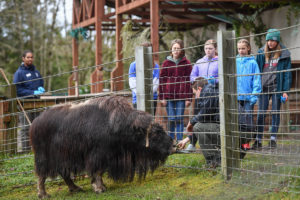
For parents of teens who won’t clean their room, it might seem amazing that six 13- and 14-year-olds would willingly spend a freezing winter morning chopping vegetables. But for the lucky teens signed up for the Keeper for a Day experience at Point Defiance Zoo & Aquarium, that was just one part of being a zookeeper.
Of course, it helps to have a muskox or porcupine just feet away while you work.
8 a.m. – Daily Briefing
“All right, welcome everybody!” called Matthew Naffziger of the zoo’s conservation engagement team as he met his charges at the gate. It was 8 a.m. on a January morning, and not much above freezing. Everyone wore thick coats and muck-proof boots. “Are you ready to do some zookeeper work?”
8:15 a.m. – Fish Pilling 101
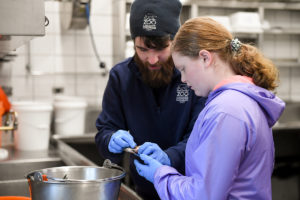
After a quick briefing, the group set off for the first task of the day: prepping vitamins for walruses. Naffziger kept up a stream of animal facts as they walked past the muskoxen and Arctic fox – knowing natural history is a crucial part of caring for animals.
Inside the marine mammal food kitchen, the temperature wasn’t much warmer. After a quick tour of the fridge room (shelves of fish and squid) and an even quicker peek into the deep freezer, the teens lined up by a stainless steel sink to learn how to hide vitamins in herring.
“So maybe you have dogs or cats at home and you have to hide their medicine in some peanut butter or something,” explained Naffziger. “This is the same idea, but walruses are much bigger, so we have way more food. And you have to know your animals well, to know what’s going to work.”
Grabbing a thawed herring, he began. “First, you wiggle the head a little. Then take a pill and shove it down into a gill slit, like this. Who wants to start?”
As Madison stepped up to take a fish with gloved hands, a zoological aide and intern worked at the other sink to prepare the afternoon’s and next morning’s seafood for seals, sea lions, sea otters, seabirds and polar bears. They’d been at it since 6 a.m. – with so many animals, especially two “teenage” male walruses, there’s a lot of diet to prep.
“I actually love it,” said Rocky Shores intern Noelle Tremonti, sluicing down the sink. “I started out here as a camp instructor and then decided to try out the zoological side. Now I really want to do it as a career.”
8:45 a.m. – Scooping Poop
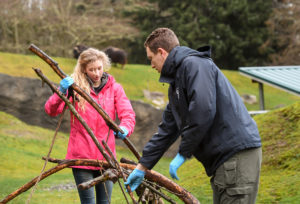
High on Muskox Hill the early winter sun angled down, turning lush grass golden and illuminating keepers, kids and animals like a 19th-century painting.
Things were rather more practical up close.
“Hi everyone, I’m Russell, and this is Malik,” began staff biologist Russell Pharr, with zoological aide Malik Johnson. “You’ll be helping us this morning doing what we do every day – scoop poop and clean up the yard for Mya, Charlotte and Hudson, to keep them healthy. Just be careful – I already got mud all over myself today.”
As Pharr and Johnson handed out shovels, rakes and a hose, the three muskoxen stood contentedly chewing: 17-year-old matriarch Mya in the side yard and the young couple Charlotte and Hudson on the grassy hill beyond a stone-like wall. As herbivores, muskoxen get through a lot of grass and leafy browse every day – and the results were dotted over the grassy hillside. But poop scooping isn’t just clean-up – it can often provide clues to an animal’s health.
The teens spread out, tall boots squelching through muddy patches. Everyone’s breath steamed in the crisp air. In the distance, a keeper was squeegeeing the windows of the polar bear habitat. Guided by Pharr, Bryden rebuilt a fort of branches for enrichment – “Muskoxen like to tear things down,” Pharr explained. As the keeper helped them cart buckets of poop to the compost bin, he chatted about wild muskoxen – where they live, what they eat, how they shed qiviut (a warm under-layer of wool).
9:45 a.m. – Seal Training
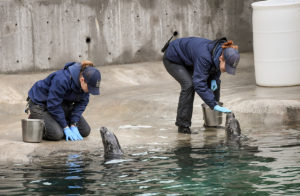
After a quick visit with new walruses Mitik and Pakak, the teen “keepers” made their way to the main Rocky Shores pool, where four keepers were spread around the perimeter. After calling harbor seals Shila, Qilak and Saya to differently-shaped and colored targets the keeper team got to work, taking the seals through a set of behaviors for health care and enrichment. As each seal rolled, laid down, touched a flipper to a face or swam between targets, she got plenty of herring in reward.
“It’s all about positive reinforcement,” said staff biologist Caryn Carter, who came up afterwards to chat. “We reward them when they’ve done what we asked, and we ignore other behaviors. And it works with siblings, colleagues – even yourself! You just need to figure out what motivates people. With seals, it’s fish.”
Laughing, the teens threw questions at Carter: How did you come to be a zookeeper? (She got a biology degree, then did some internships.) How do you clean the pools? (Drain them, then get in there with brushes.) What are the most challenging animals to work with? (Every animal has its challenges – that’s what makes the job interesting.)
10:40 a.m. – Lettuce in, compost out
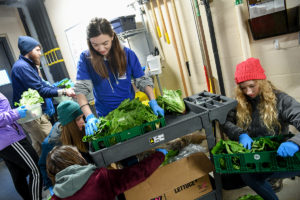
After a warm-up snack break, the teens headed over to the other side of the zoo – the Asian Forest Sanctuary. After learning how keepers shift tigers in and out of the five rotational habitat areas, the group was radioed in behind the scenes by staff biologist Alicia Chapman. A big box of lettuce needed counting and sorting into tubs marked “anoa” and “tapir.” A big part of zookeeper work is to make sure each animal gets the right amount of food each day.
In the room just behind them the prickle of porcupines slept soundly in a pile of hay, and a strong scent of tiger hung in the air.
“Woah,” said Cora.
Lettuce sorted, the group filed back outside to deal with the end result – a barrel marked “anoa compost” that needed emptying into a giant dumpster.
11:30 a.m. – Goats, veggies, sharks
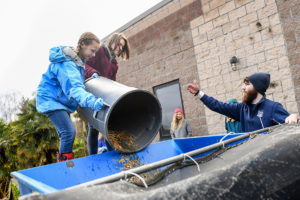
And then it was lunchtime. On the schedule for the afternoon: stuffing hay into wiffle balls for goat enrichment, chopping vegetables for other animals and a free-choice of aquarium visit or exploring biofacts like fur or horns.
After all this poop scooping, food prep and learning, did any teen think they might become a zookeeper?
“After today, it’s definitely a fair option,” said Ava.
“I do want to be a zookeeper,” offered Elizabeth. “And I already have chickens so I’m used to cleaning up.”
“I have lots of animals at home,” added Bryden shyly, “I’d like to be a vet.”
But Madison had the final word: “It’s so cool!” she said with a big smile.
SIGN ME UP: Adults or teens can sign up for our Keeper for a Day or Marine Biologist for a Day experiences here. (NOTE: Activities vary with each experience depending on animal and keeper needs.)